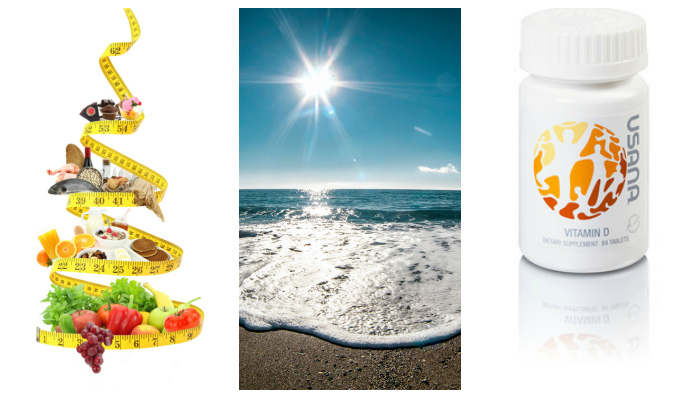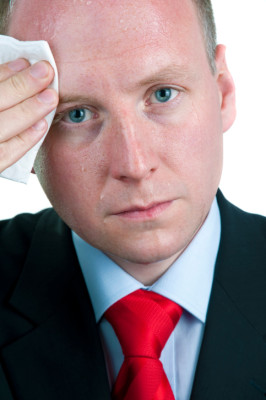Vitamin D Deficiency: The Truth Revealed
Updated: Feb. 17, 2017
So this one time I wrote a super cool blog post about vitamin D. It was a pretty thorough explanation of this important micronutrient, but looking back, I think it might be more beneficial to talk about those with a vitamin D deficiency. Because I can tell you that it’s simply not a good problem to face. Wait…are any problems considered good ones? I guess getting an overload of fancy job offers wouldn’t be the wor…shoot, I’m getting off topic, huh?
Let’s get down to business—vitamin D business.
What is it?
Vitamin D is a micronutrient that our bodies depend on for a variety of functions. Besides being important to keeping bones strong and healthy, vitamin D supports your healthy muscles, heart, lungs, and brain function. Oh, and it helps your immune system, too. Pretty cool, right?*
 The problem with this stuff is that we don’t produce it naturally. Yep, it’s kind of a bummer, I know. But vitamin D comes from only three sources: through exposure to the sun, certain foods, and supplements.
The problem with this stuff is that we don’t produce it naturally. Yep, it’s kind of a bummer, I know. But vitamin D comes from only three sources: through exposure to the sun, certain foods, and supplements.
What’s the Best Way to Get it?
Turns out, relying solely on your diet is not a good idea when it comes to maintaining proper vitamin D levels. There just aren’t enough foods with high enough levels to get what your body needs. And that leaves us with the sun and supplementation as our go-to resources for avoiding vitamin D deficiency.
Now before you go off to bask in the beautiful sunshine, let’s talk about how it can impact your health.
Every time we expose our bare skin to direct sunlight, we use ultraviolet B (UVB) rays to produce vitamin D3 (cholecalciferol). Sunlight can be a tricky thing, though, because too much can be a bad thing. You need to monitor how much sun exposure is needed for healthy vitamin D levels. Otherwise, you might face some scary skin issues later in life.
Oh, and the amount of vitamin D you actually absorb from sunlight differs depending on the time of day and year, where you live, and the color of your skin. So those winter rays don’t necessarily produce the same amount of vitamin D that summer rays do.
See what I mean about tricky?
How Do you Know You’re Running Low? (signs of vitamin D deficiency)
Okay, the truth is that the only surefire way to know if you’re dealing with vitamin D deficiency is to have your blood tested by a physician. But that doesn’t mean you can’t keep an eye out for symptoms associated with vitamin D deficiency. Below are the symptoms and signs I was able to dig up (you’re lucky to read it here, but since USANA is a trusted partner and sponsor of The Dr. Oz Show, our own Brian Dixon, Ph.D., explained a lot of this on television as well).
Turns out, when you run low on vitamin D, it takes a pretty serious toll on your mood. This is because our brains produce serotonin—a hormone that affects our moods—at a higher rate when we’re exposed to sunshine or bright light. And as I mentioned, more exposure to sunlight means more vitamin D.
Skin Color
Those with darker skin are at a higher risk for vitamin D deficiency, because skin pigment has a direct correlation with how much vitamin D is absorbed. Some research suggests that those with darker skin may need up to 10 times more sun exposure than those with lighter skin to produce a comparable amount of vitamin D.
Age
Besides the fact that older people usually spend more time indoors (okay, maybe that’s just my grandparents?), aging correlates to vitamin D deficiency in a couple of ways. First, the skin loses its ability to absorb as much vitamin D as we get older. And second, our kidneys slowly become less effective at converting vitamin D into the form used by our bodies.
Excessive sweating (specifically, on your forehead) is a very common symptom of those facing vitamin D deficiency. So if you’re constantly wiping the sweat off your brow (outside of the gym), you might want to look into that blood test I mentioned earlier.
Achy Bones
Many people who are unknowingly deficient in vitamin D will complain of bones and joints that are achy or painful. This is because vitamin D is very important for maintaining strong bones.
Calcium and phosphorus are essential for developing a healthy structure and strength of your bones, and you need vitamin D to absorb these minerals. There’s no “bones” about it. (Sorry, I couldn’t resist a bad pun.)* For more on that, take a look at this handy bone health infographic.
Excessive Weight
 The thing about vitamin D is that it’s fat-soluble—meaning that the fat in our bodies is how we collect and store it. So if you’re overweight, the excessive amount of fat in your body needs a comparable amount of vitamin D to absorb. So you’ll need a lot more vitamin D than someone with a low percentage of body fat.
The thing about vitamin D is that it’s fat-soluble—meaning that the fat in our bodies is how we collect and store it. So if you’re overweight, the excessive amount of fat in your body needs a comparable amount of vitamin D to absorb. So you’ll need a lot more vitamin D than someone with a low percentage of body fat.
Gut Problems
Like I just mentioned, vitamin D is fat-soluble vitamin. So certain gut conditions that cause a lower absorption of fat can also lower your absorption of vitamin D. Sorry, I need to get my mind out of the “gutter.” (You can’t stop me.)
What Happens When You Don’t Get Enough?
Okay, so now you know all about vitamin D and why it’s important. But do you know what it means if you happen to be someone struggling with vitamin D deficiency? It’s not good, people.
As doctors continue to discover the benefits of healthy vitamin D levels, more and more research indicates that a lack of vitamin D may lead to other health issues other than the ones I mention above. Some people even believe that because vitamin D deficiency often goes undiagnosed, doctors attribute a person’s vitamin D deficiency symptoms to other health conditions that they don’t actually have.
So, if you’re not picking up what I’m putting down, vitamin D deficiency is not something you want to deal with…like ever. Visit the vitamin D council’s website to see what their research has uncovered. I used a good chunk of their research to write this post.
So How Much Do You Need?
Okay, are you ready for me to stop talking at you and tell you just how much vitamin D you need? Well, let me explain…
As far as how much you need, that depends on who you’re asking. Every person has different needs, but many researchers believe that further research will eventually prove that the U.S. government recommendations aren’t high enough. Your safest bet is to talk to your doctor and have your vitamin D levels tested every three months.
Check out the fancy chart I snagged from the Vitamin D Council below to see the different vitamin D recommendations, and be sure to share this important information with your friends and family.
Oh, and don’t forget that supplementation is a super reliable way to get your vitamin D. Just one of USANA’s Vitamin D tablets provides 2,000 IU of vitamin D3, which is the same type of vitamin D your body produces when exposed to sunlight. And guess what else? For most people, vitamin D is easily absorbable and always important to maintain. So you could probably reap some of the benefits of taking a vitamin D supplement on a daily basis.
And while you’re doing all this research, don’t forget to check out the vitamin D section on USANA’s Ask the Scientists website.
References: http://www.vitamindcouncil.org/
| *These statements have not been evaluated by the Food and Drug Administration. This product is not intended to diagnose, treat, cure, or prevent any disease. |
We’re proud to bring you the freshest content on the web! Follow USANA on Twitter, like our USANA Facebook page and enjoy the latest videos on the official USANA YouTube channel.
 Learn what USANA is doing to make the world a better place.
Learn what USANA is doing to make the world a better place.
The future of personalized health and nutrition is now available with USANA’s True Health Assessment.











Can a person take too much vitamin d?